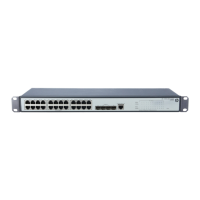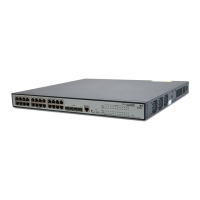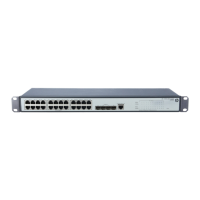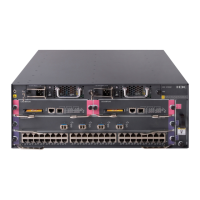176
As shown in Figure 162, the priority values of Device A, Device B, and Device C are 0, 1, and 2, and the
path costs of links among the three devices are 5, 10 and 4 respectively.
Initial state of each device
Table 71 Initial state of each device
Device Port name BPDU of port
Device A
AP1 {0, 0, 0, AP1}
AP2 {0, 0, 0, AP2}
Device B
BP1 {1, 0, 1, BP1}
BP2 {1, 0, 1, BP2}
Device C
CP1 {2, 0, 2, CP1}
CP2 {2, 0, 2, CP2}
Comparison process and result on each device
Table 72 Comparison process and result on each device
Device Comparison process
Configuration BPDU on
arison
Device A
Port AP1 receives the configuration BPDU of Device B {1, 0, 1,
BP1}. Device A finds that the configuration BPDU of the local
port {0, 0, 0, AP1} is superior to the received configuration
BPDU, and therefore discards the received configuration BPDU.
Port AP2 receives the configuration BPDU of Device C {2, 0, 2,
CP1}. Device A finds that the BPDU of the local port {0, 0, 0,
AP2} is superior to the received configuration BPDU, and
therefore discards the received configuration BPDU.
Device A finds that both the root bridge and designated bridge
in the configuration BPDUs of all its ports are itself, so it assumes
itself to be the root bridge. In this case, it does not make any
change to the configuration BPDU of each port, and starts
sending out configuration BPDUs periodically.
AP1: {0, 0, 0, AP1}
AP2: {0, 0, 0, AP2}
Device B
Port BP1 receives the configuration BPDU of Device A {0, 0, 0,
AP1}. Device B finds that the received configuration BPDU is
superior to the configuration BPDU of the local port {1, 0, 1,
BP1}, and updates the configuration BPDU of BP1.
Port BP2 receives the configuration BPDU of Device C {2, 0, 2,
CP2}. Device B finds that the configuration BPDU of the local
port {1, 0, 1, BP2} is superior to the received configuration
BPDU, and therefore discards the received configuration BPDU.
BP1: {0, 0, 0, AP1}
BP2: {1, 0, 1, BP2}

